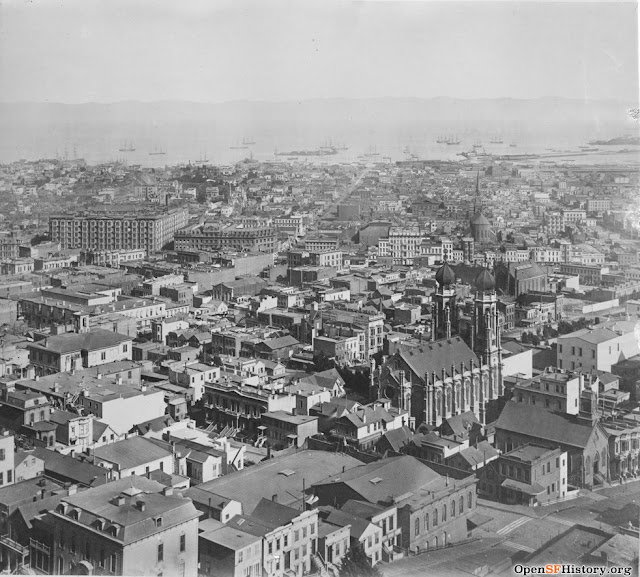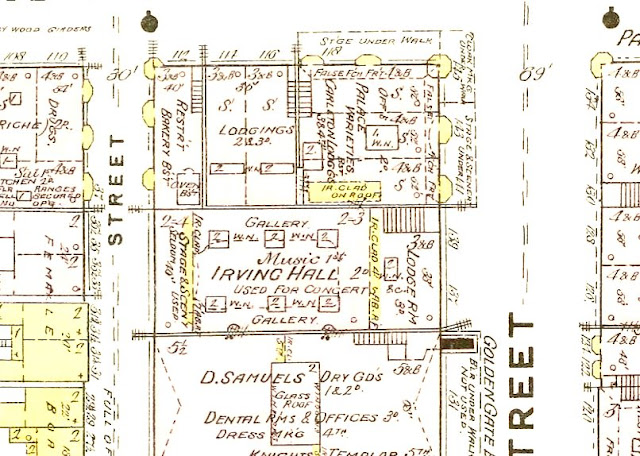139 Post St. | map |
The rear and east wall of Dashaway Hall are seen in the center
of this 1867 image. The
rear of the hall with the stage was on Morton St., now called Maiden
Lane. The windows on the side wall were at the hall's balcony level. It's a photo by Thomas Houseworth taken from 3rd and Market that appears on the Open SF History Project website.
An 1873 ad for a Somerset Social Club Ball at the Dashaway. Thanks to Mark Reed for locating this in the July 19 issue of The Elevator. It was included in a post on the San Francisco History to 1915 Facebook page discussing venues where events for African-Americans were held. Mark comments on the August 6 ball:
"... In August the following year (1873) the Somerset Social Club sponsored its first 'public entertainment' -- a Grand Ball at Dashaway Hall, 139 Post. The Elevator (9 Aug) reported that the Ball was a 'decided success... patronized by a large company... A novel feature was introduced called the "Moonlight Quadrilles," illustrated by beautiful Calcium Prismatic lights. The effect was beautiful and elicited the approbation of the guests.' Although a success, the Elevator noted a tense encounter -- 'several white young men entered the hall with their hats on smoking cigars. They were rebuked by the managers, but they should have been expelled immediately.'"
Mark notes that the August 9, 1873 Elevator is available on the website of the California Digital Newspaper Collection.
The Pacific Coast Architecture Database has a page about Dashaway Hall. One of their comments:
"San Francisco citizens interested in establishing the city's first public library gathered at Dashaway Hall in 1877 to discuss the issue. Andrew Hallidie (1836-1900), the cable car developer, convened the meeting."
Dashaway Hall is in the center of this detail Art Siegel extracted from the 1877 Muybridge image. Thanks, Art!
The Dashaway Society was disbanded in 1883. In 1884 the building was sold and renamed Irving Hall. Evidently the new owners had thought of calling it the Irving Opera House. Thanks to Art Siegel for locating this item in the April 15, 1884 Daily Alta California:
Events in May 1884 at the "Late Dashaway Hall." Thanks to Art Siegel for locating the ads in the May 7, 1884 Daily Alta California. The issue is on the CDNC website. Fowler's last performance was May 6, the night before the ad appeared. But the big occasion was the "Grand Opening," celebrated with a ball on May 8.
The July 25, 1885 Daily Alta California
had a description of the decorations at the hall following the death of
Ulysses S. Grant. Thanks to Art Siegel for locating this on the CDNC
site. The paper did a survey of decorations all over town. In their "On Post Street" section they noted:
In 1886 a speaker at Irving Hall discussed the Dashaways and how they lost the property. Art Siegel located it in the January 11, 1886 Daily Alta California:
"THE DASHAWAY STEAL - R. Guy McClellan Graphically Recounts the History of It. A very large audience was present at the meeting of the Temperance Legion at Irving Hall last evening, the attraction being an announced lecture by R. Guy McClellan on the 'History of the Dashaways.' Mr. McClellan was introduced by the President, and after a humorous prelude entered into the subject of his lecture.
" 'Twenty-five years ago,' said the speaker, 'a number of drinking men met in an engine-house in this city, and when they had filled their glasses with liquor, suddenly resolved unanimously to quit the habit of drinking from that time on, and the result was they all dashed their caps down, or dashed them away, from which act they took the name of the Dashaways. They formed themselves into a society for the promulgation of temperance. There were in the new association such men as Chief Whitney, Judge Weed and Dr. Henry Gibbons. Shortly after their organization I became a member.
" 'The good work went on, and the association grew in popular favor until it became the talk of the town. Subscriptions were taken up for it, and nearly every one subscribed something; even saloon men gave a few dollars each. With the money thus acquired we bought the ground where this building now stands, and put up a building in which was a meeting hall. In that hall there were some rousing meetings and grand music. Hundreds of men walked up at every meeting and signed the pledge to abstain from intoxicating liquors. Sorrowing wives were made happy and altogether we did a great deal of good.
" 'In the midst of this great success Dr. Gibbons came to me and asked me if I would sign for the organization of another temperance society in another part of the city. I told him that I would, and for a dozen, gladly. I signed, and the Temperance Legion was organized. I then left for Boston, and while there received a letter which stated that Chief Whitney, Judge Weed, Dr. Gibbous and myself had been expelled from the Dashaway Association. The reason for the expulsion I will give you: They had gone away back in the Constitution and had found a blind clause which said that no member could belong to any other temperance society. We had joined the Temperance Legion, for which offense we were expelled.'
"THE FIRST MOVE. 'This was the preliminary step for grabbing this property. Shortly after our expulsion they ceased giving public meetings. The lights were turned out; no more music; all about the building was dark, dreary and foreboding. The building that had been constructed by a charitable public for charitable purposes was taken from the people to which it rightfully belonged. The members dropped out one by one. Step by step they drew closer the lines of their conservative conclave. Members were watched, and when found drunk were instantly expelled. Spies were put upon their tracks to watch them and to lure them into saloons and to drink, that a reason might be found for their dismissal. When a member died they thanked God for it. They had no more right to appropriate that building then I have to take the hat off a stranger's head. I am glad to be able to say, however, that there were but a few of the old original members in the steal, for such it was. They put this property under the hammer and knocked it down for $160,000, and like midnight highwaymen, divided the proceeds of the sale.' The lecturer spoke with great feeling and in a very eloquent manner, and was frequently applauded."
Closing: Irving Hall was auctioned off in 1886. A sale of a number of properties, this one among them, was announced in the July 19, 1886 Daily Alta California. Thanks to Art Siegel for locating this item in the "Real Estate" column:
An item in the August 12, 1886 Daily Alta California announced the results of the sale:
"Used for Concerts." Irving Hall is seen in the center of this detail from image 23 of the 1887 Sanborn Real Estate Survey Map. Thanks to Art Siegel for locating it in the Library of Congress collection. He notes that here they show it as a three story building.
The wrap-around balcony was on the second floor and a lodge room was on 3. They show the "Stage and Scenery" as "Seldom Used." That's Morton St. on the left, now called Maiden Lane. On the right it's Post St. Note the Palace Varieties, a basement venue, in the building to the west, on the corner of Post and Grant.
Litigation among the Dashaways was discussed in the November 23, 1989 Daily Alta California. Thanks to Art Siegel for locating this story:
"THE DASHAWAYS. A New Trial Ordered in the Suit Brought by Charles Ashton. MISAPPROPRIATION OF FUNDS. The Supreme Court Holds That the Association Was Not Incorporated for Pecuniary Profit. The Supreme Court yesterday rendered a decision ordering a new trial in the case of Charles Ashton vs. the Dashaway Association. This was a suit by Charles Ashton, a member of the Dashaway Association, against the corporation, its five trustees, and a majority of the other members, to compel the restoration of funds alleged to have been misappropriated. The trial Court nonsuited the plaintiff, who appealed from an order denying his motion for a new trial.
"The original association was an incorporated temperance society. It was formed in January, 1859, at the Howard Engine House, by seventeen men, who took a pledge to abstain from all intoxicating drinks, except for medical purposes, the necessity of which was to be certified by a physician... In 1860 the association purchased a lot on Post street, near Dupont, for $6250, and erected a building. This is the property now known as Irving Hall. In 1862 the association was incorporated. The articles stated that the organization was 'a benevolent association formed for the purpose of promoting the cause of temperance.' There were 3163 names before the incorporation and 4904 since the incorporation. In 1882 the membership had dwindled to 59.
"In the following year notice was given of a meeting of members to consider the question of selling the property in order to pay the debts, and to reinvest in other property. The Superior Court granted leave to sell the property. The property was sold for $156,000. Of this sum $45,000 was used in discharging indebtedness, $31,543.54 was placed in savings banks, where it is to be presumed it now is, and $73,500 was divided among 49 members, including the trustees. The answers to Ashton's complaint deny that the defendants 'unlawfully or fraudulently' took or received any of the money, or that they took or received any money 'that was held by said corporators in trust,' but do not deny the taking or receiving, and the evidence of the taking is uncontradicted. At a meeting of the members held in December 1883, the minute book shows that a resolution was adopted donating to each member in good standing $1500 for past services. Forty-nine members came in for this benefit.
"The Supreme Court says: 'In the present case there was a plain misappropriation of corporate funds. The corporation was not dissolved, or so far as appears, to be dissolved. It was a simple case of trustees who were in possession and in control of corporate funds, acting in pursuance of a vote of the majority of its members, "donating" the corporate funds to themselves and other members, upon the pretext of "past services," although the fact was, as admitted at the trial, that no services had been rendered other than such as the parties were bound to render as members of the Association...'
"There is another suit against the association which the Supreme Court will probably pass upon this month. It is entitled The People of the State of California vs. The Dashway Association. It was brought in the Superior Court, the prayer of the complaint being that the association be disincorporated, that a receiver be appointed, that its property escheat to the State and that the trustees be enjoined from appropriating or dividing up any of the funds... It will be remembered that after Ashton had begun his suit against the association one of the members, who had shared in the division, shot him, making a severe wound in the neck. For a long time Ashton was in a critical condition, but finally recovered."
More information: See "Early Day Theatricals," an article in the April 21, 1901 San Francisco Call. It's on the CNDC website.
Jack Tillmany's Arcadia Publishing book "Theatres of San Francisco" can be previewed on Google Books. It's available from Amazon or your local bookseller.
| back to top | San Francisco Theatres: by address and neighborhood | alphabetical list | list by architect | pre-1906 theatre list | home |

















No comments:
Post a Comment